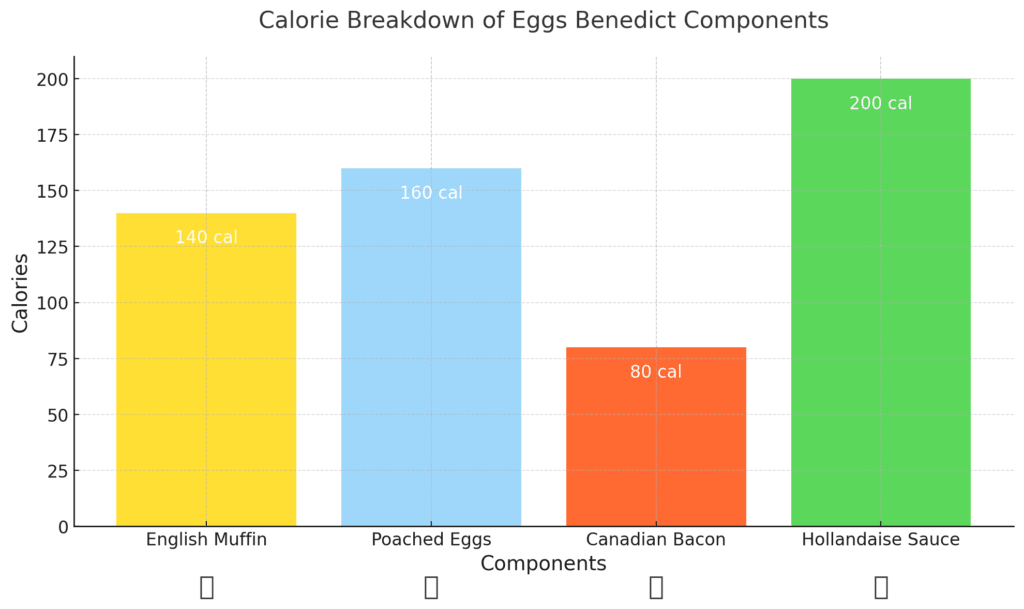introduction
Eggs Benedict, a timeless breakfast classic, offers a rich mix of textures and flavors that make mornings feel special. From the crisp English muffin to the creamy hollandaise sauce, each layer contributes to its mouthwatering appeal. But have you ever wondered how many calories are packed into this indulgent dish? Whether you’re counting calories, seeking healthier tweaks, or simply curious, this article will break down everything you need to know about the calories of Eggs Benedict. We’ll explore its nutritional profile, provide tips for customization, and compare it with other popular breakfast options. Let’s dig in!
Understanding Eggs Benedict
What is Eggs Benedict?
Eggs Benedict is a quintessential breakfast or brunch dish known for its layered presentation. Traditionally, it consists of a halved English muffin topped with Canadian bacon, a perfectly poached egg, and a generous drizzle of hollandaise sauce. Each ingredient brings a unique taste and texture, making it a beloved choice for many.
Key Ingredients in Eggs Benedict
This dish owes its charm to a few staple ingredients. The English muffin provides a hearty base, while Canadian bacon adds a savory touch. Poached eggs lend creaminess and protein, and the velvety hollandaise sauce ties everything together. A sprinkle of fresh herbs often finishes the dish, giving it a gourmet flair.
The Popularity of Eggs Benedict in Breakfast Culture
Eggs Benedict isn’t just food; it’s an experience. Whether served at upscale brunches or cozy diners, this dish has become synonymous with indulgence. Its versatility allows chefs to create countless variations, catering to a wide range of tastes while keeping its iconic identity intact.
Stay tuned as we delve into the calorie breakdown of these components and uncover how you can make this delightful dish a tad healthier without losing its magic.
Calories Breakdown of Eggs Benedict Components
Calories in the English Muffin
The English muffin serves as the foundation of Eggs Benedict, providing a soft yet sturdy base. On average, a single whole English muffin contains about 120 to 140 calories. However, this can vary depending on the brand and whether it’s whole-grain or enriched flour. Adding butter to toast the muffin can increase the calorie count by an additional 35 to 50 calories.
To keep the calories of Eggs Benedict in check, opt for whole-grain or low-calorie alternatives. They’re not only healthier but also packed with fiber, which keeps you fuller for longer.
Calories in Poached Eggs
Eggs are a nutritional powerhouse and a vital ingredient in Eggs Benedict. A single poached egg contains approximately 70 to 80 calories. Poaching is one of the healthiest ways to cook eggs since it doesn’t require added fat like frying does. This keeps the calorie count low while maintaining all the protein-packed goodness.
If you’re watching your calorie intake, you might consider reducing the number of eggs in your serving. Alternatively, egg whites can be used as a lower-calorie option, trimming about 50% of the calories.
Calories in Canadian Bacon
Canadian bacon adds a smoky, savory flavor to the dish, but it’s also one of the lower-calorie meats. Each slice has around 30 to 40 calories, making it a relatively light protein option. However, some recipes call for multiple slices, which can double or even triple the calorie count.
To reduce the calories of Eggs Benedict, you could swap Canadian bacon for turkey bacon or even smoked salmon. These alternatives not only save calories but also provide unique flavors.
Calories in Hollandaise Sauce
Here’s where things get indulgent. Hollandaise sauce, a creamy blend of butter, egg yolks, and lemon juice, is the calorie-dense crown jewel of Eggs Benedict. A standard serving can contribute 150 to 200 calories, depending on the portion size and recipe.
For a lighter twist, consider making your hollandaise sauce with low-fat yogurt or using a smaller drizzle. This simple swap can make a huge difference in reducing the overall calories of Eggs Benedict without sacrificing its luxurious taste.
Customizing Eggs Benedict for Lower Calories
Using Whole-Grain or Low-Calorie Muffins
Switching to a whole-grain English muffin is a smart move for reducing calories while boosting nutritional value. Whole grains are rich in fiber, which aids digestion and helps you feel full. You could also explore low-calorie options that taste just as satisfying without the added calories.
Alternatives to Canadian Bacon
If you’re open to experimenting, swapping out Canadian bacon for leaner proteins like turkey bacon, grilled chicken, or smoked salmon can cut down on calories. Plant-based options like grilled vegetables or avocado slices also add flavor and texture with fewer calories.
Healthier Options for Hollandaise Sauce
Traditional hollandaise sauce is undeniably delicious, but it’s loaded with butter. By using Greek yogurt or avocado as a base, you can create a sauce that’s equally creamy and far less calorie-heavy. Another trick is to use lemon juice and Dijon mustard for a tangy topping that mimics the original.
Adding Vegetables to Your Plate
Amping up the vegetable content is a great way to lower the calorie density of your meal. Add steamed spinach, sautéed mushrooms, or sliced tomatoes to your Eggs Benedict for added nutrients and fewer calories. Not only do they enhance the dish’s flavor, but they also increase the portion size without adding many calories.
These small tweaks allow you to enjoy the calories of Eggs Benedict guilt-free while maintaining its signature taste and charm. Stay tuned for more insights as we explore how cooking methods and comparisons with other dishes play a role in this classic meal.
Calories Breakdown of Eggs Benedict Components

Calories in the English Muffin
The English muffin, a key ingredient in Eggs Benedict, provides a soft and slightly chewy base. On average, a single whole English muffin contains about 120 to 140 calories. However, the calorie count can vary depending on whether the muffin is made from refined or whole-grain flour. Whole-grain versions tend to offer more fiber, keeping you satisfied longer while providing the same calorie content.
For those looking to cut down the calories of Eggs Benedict, choosing smaller-sized muffins or low-calorie varieties can make a big difference without sacrificing the dish’s structure.
Calories in Poached Eggs
Poached eggs are not only delicious but also one of the healthiest ways to prepare eggs. Each poached egg contains approximately 70 to 80 calories. Since poaching requires no added fat, it helps maintain the dish’s calorie count on the lower side.
Eggs are a fantastic source of protein and nutrients like vitamin D and choline. If you’re looking to reduce the calories of Eggs Benedict further, using only egg whites could cut the calorie count in half while still offering a decent amount of protein.
Calories in Canadian Bacon
Canadian bacon, a leaner option compared to traditional bacon, contributes about 30 to 40 calories per slice. Typically, two slices are used in a serving, adding up to approximately 60 to 80 calories. While flavorful, some recipes incorporate additional slices, which can significantly raise the overall calorie count.
If you want to keep the calories of Eggs Benedict lighter, try using turkey bacon, ham, or even a plant-based alternative. These swaps provide similar flavors with fewer calories.
Calories in Hollandaise Sauce
Hollandaise sauce is where the calorie count can skyrocket. A standard serving of this rich and creamy sauce contains between 150 to 200 calories, mainly due to its high butter content. For many, the sauce is what makes Eggs Benedict irresistible, but it’s also the most calorie-dense component.
To manage the calories of Eggs Benedict, you can make a lighter hollandaise at home using Greek yogurt, lemon juice, and a touch of mustard. Alternatively, use just a drizzle to keep the dish flavorful but less heavy.
Customizing Eggs Benedict for Lower Calories
Using Whole-Grain or Low-Calorie Muffins
Switching to whole-grain or low-calorie English muffins is a simple yet effective way to cut back on calories without compromising taste. Whole-grain options are higher in fiber, which can help keep you feeling full longer, making them an excellent choice for a healthier Eggs Benedict.
For an even lighter twist, consider halving the muffin or replacing it with a slice of sweet potato or roasted vegetable.
Alternatives to Canadian Bacon
Canadian bacon is already a lower-calorie meat, but there are even leaner options. For instance, turkey bacon or grilled chicken breast can save calories while adding their own unique flavors. Vegetarians can opt for avocado slices or roasted vegetables like zucchini or bell peppers.
These swaps not only lower the calories of Eggs Benedict but also add variety to the dish, keeping it fresh and exciting.
Healthier Options for Hollandaise Sauce
Hollandaise sauce is a calorie-heavy topping, but it doesn’t have to be. Making your own at home using healthier ingredients like low-fat yogurt or blended cashews can significantly cut down on calories. Even small tweaks, like reducing the amount of butter or using olive oil, can make a noticeable difference.
If you’re short on time, try a light lemon and mustard sauce as a tangy alternative that pairs beautifully with poached eggs.
Adding Vegetables to Your Plate
Adding vegetables is an easy way to lower the calorie density of your meal while boosting its nutritional value. Spinach, tomatoes, or mushrooms make excellent additions to the plate. Not only do these veggies enhance the flavors, but they also provide essential vitamins and minerals.
By customizing your plate with more veggies, you can reduce the calories of Eggs Benedict while creating a meal that’s both balanced and satisfying.
How Cooking Methods Impact Calories
Grilling vs. Frying Bacon
Cooking methods can significantly influence the calories of Eggs Benedict, particularly when it comes to preparing the bacon. Grilling Canadian bacon is a healthier option as it eliminates the need for added fats. On the other hand, frying often involves oil or butter, which can add an extra 50–100 calories per serving.
If you’re looking to make a lighter version of Eggs Benedict, opt for grilling or broiling your bacon. These methods help retain the flavor while keeping the calorie count in check.
Preparing Hollandaise Sauce at Home vs. Store-Bought
Hollandaise sauce is the star of Eggs Benedict but can also be its most calorie-dense component. Store-bought versions are convenient but often contain preservatives and excess fats, increasing the calorie count. Homemade hollandaise allows you to control the ingredients, such as reducing butter or replacing it with healthier alternatives like olive oil.
By preparing the sauce at home, you can easily cut the calories of Eggs Benedict without compromising on taste.
Impact of Butter and Oil on Calorie Count
Whether it’s toasting the muffin or cooking the bacon, the use of butter and oil plays a significant role in the overall calorie content. A tablespoon of butter or oil adds roughly 100 calories. Reducing or substituting these fats with cooking spray or nonstick cookware can make a big difference.
Small adjustments, like using less butter or skipping it entirely, can help you enjoy Eggs Benedict with fewer calories.
Nutritional Comparison with Other Breakfast Dishes
Eggs Benedict vs. Pancakes
When it comes to breakfast, pancakes are another popular choice. However, a standard serving of pancakes with syrup can contain 350 to 500 calories, often more than a traditional serving of Eggs Benedict. Pancakes are also higher in sugar, whereas Eggs Benedict provides more protein.
For a balanced breakfast, Eggs Benedict may be the better choice, especially if you tweak it to reduce the calorie count.
Eggs Benedict vs. Omelets
Omelets are another classic breakfast dish that can rival Eggs Benedict in terms of calories. A cheese-loaded omelet can easily reach 400 to 600 calories, depending on the fillings. However, omelets are versatile, and adding vegetables instead of cheese or meats can significantly lower their calorie content.
When compared to a traditional Eggs Benedict, the calories of Eggs Benedict may be slightly higher, but its balanced composition offers a satisfying and indulgent experience.
Eggs Benedict vs. Avocado Toast
Avocado toast has gained fame as a trendy and healthy breakfast option. Depending on the portion size and toppings, avocado toast usually contains 250 to 400 calories. While it’s packed with healthy fats, it may not be as filling as Eggs Benedict, especially if the latter includes added protein like eggs and bacon.
If you’re after a hearty breakfast, the calories of Eggs Benedict can be worth it, particularly when paired with lighter, nutrient-rich ingredients.
Suggestion for Further Reading
For more delicious recipes and meal ideas, check out the Calories of Eggs Benedict Recipe Guide on Vivid Meals.
Frequently Asked Questions
How Many Calories Are in a Traditional Eggs Benedict?
The calories of Eggs Benedict can vary widely depending on the portion size and preparation method. On average, a single serving with an English muffin, two poached eggs, two slices of Canadian bacon, and a generous drizzle of hollandaise sauce contains 400 to 600 calories. This number can increase if additional butter or oil is used during cooking.
If you’re dining out, restaurant versions of Eggs Benedict might be even higher in calories due to larger portions or richer hollandaise sauces. To better estimate, always check the menu or ask for nutritional information.
Are There Low-Calorie Versions of Eggs Benedict?
Absolutely! There are several ways to reduce the calories of Eggs Benedict while keeping the flavors intact. Swapping the traditional English muffin for a whole-grain or low-calorie alternative is an excellent start. Additionally, using turkey bacon or grilled vegetables instead of Canadian bacon can lower the calorie count significantly.
Another easy adjustment is lightening the hollandaise sauce by using Greek yogurt or skipping it altogether in favor of a zesty lemon-based drizzle.
How Can I Reduce Calories Without Sacrificing Flavor?
The key to maintaining the essence of Eggs Benedict while reducing calories lies in making small, smart swaps. For instance, poaching eggs without added fat, grilling bacon instead of frying, and using a lighter hollandaise sauce can all make a big difference. You can also add fresh veggies like spinach or tomatoes to your plate to increase volume without adding many calories.
With these adjustments, you can enjoy a delicious and satisfying version of Eggs Benedict without worrying about excessive calories.
Conclusion and Final Thoughts
The calories of Eggs Benedict don’t have to be a mystery or a deal-breaker for those who love this classic breakfast. By understanding the components of the dish and how each contributes to the overall calorie count, you can make informed choices that suit your dietary needs and preferences.
Whether you’re enjoying the traditional recipe or experimenting with low-calorie variations, Eggs Benedict remains a versatile and indulgent meal. With a few simple tweaks, it can easily fit into a balanced diet, offering the perfect blend of taste, nutrition, and satisfaction.
If you’re looking for more breakfast inspiration, be sure to explore the Calories of Eggs Benedict Recipe Guide for creative twists and healthier takes on this beloved dish.

